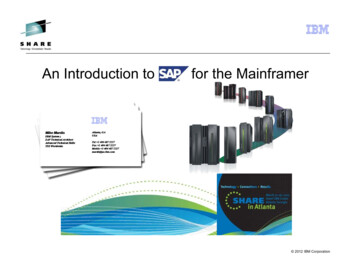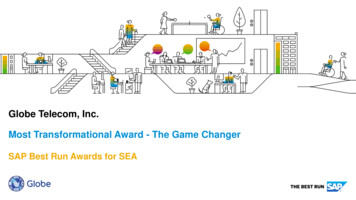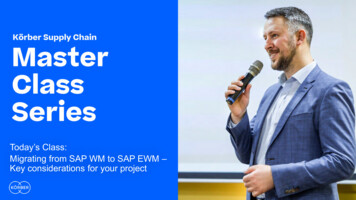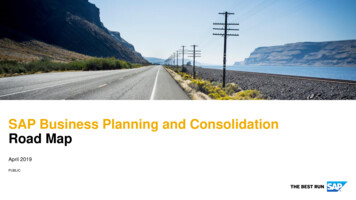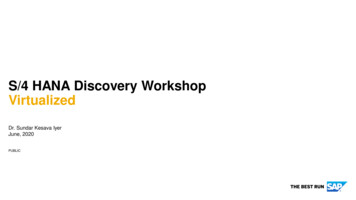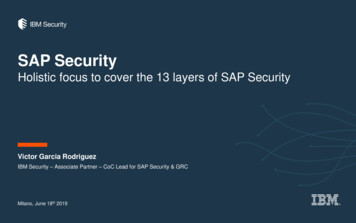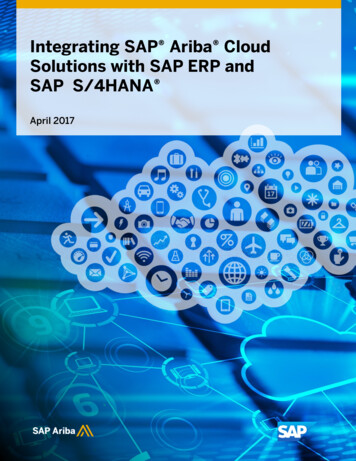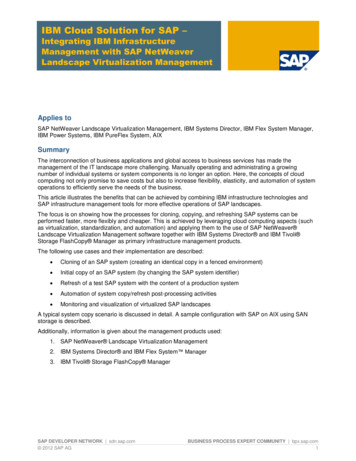
Transcription
IBM Cloud Solution for SAP –Integrating IBM InfrastructureManagement with SAP NetWeaverLandscape Virtualization ManagementApplies toSAP NetWeaver Landscape Virtualization Management, IBM Systems Director, IBM Flex System Manager,IBM Power Systems, IBM PureFlex System, AIXSummaryThe interconnection of business applications and global access to business services has made themanagement of the IT landscape more challenging. Manually operating and administrating a growingnumber of individual systems or system components is no longer an option. Here, the concepts of cloudcomputing not only promise to save costs but also to increase flexibility, elasticity, and automation of systemoperations to efficiently serve the needs of the business.This article illustrates the benefits that can be achieved by combining IBM infrastructure technologies andSAP infrastructure management tools for more effective operations of SAP landscapes.The focus is on showing how the processes for cloning, copying, and refreshing SAP systems can beperformed faster, more flexibly and cheaper. This is achieved by leveraging cloud computing aspects (suchas virtualization, standardization, and automation) and applying them to the use of SAP NetWeaver Landscape Virtualization Management software together with IBM Systems Director and IBM Tivoli Storage FlashCopy Manager as primary infrastructure management products.The following use cases and their implementation are described: Cloning of an SAP system (creating an identical copy in a fenced environment) Initial copy of an SAP system (by changing the SAP system identifier) Refresh of a test SAP system with the content of a production system Automation of system copy/refresh post-processing activities Monitoring and visualization of virtualized SAP landscapesA typical system copy scenario is discussed in detail. A sample configuration with SAP on AIX using SANstorage is described.Additionally, information is given about the management products used:1. SAP NetWeaver Landscape Virtualization Management2. IBM Systems Director and IBM Flex System Manager3. IBM Tivoli Storage FlashCopy ManagerSAP DEVELOPER NETWORK sdn.sap.com 2012 SAP AGBUSINESS PROCESS EXPERT COMMUNITY bpx.sap.com1
IBM Cloud Solution for SAP – Integrating IBM Infrastructure Management with SAP NetWeaver Landscape Virtualization ManagementAuthors:Olena Demeter, SAP AG, GermanyAndreas Krebs, SAP AG, GermanyStefan Luthe, SAP AG, GermanyArnold Beilmann, IBM Deutschland Research & Development GmbHGerd Kehrer, IBM Deutschland Research & Development GmbHWolfgang Reichert, IBM Deutschland Research & Development GmbHCompany: SAP and IBMCreated on: June 1, 2012Author BioOlena Demeter is Product Owner for Post Copy Automation ABAP (PCA). PCA ABAP isbeing delivered as part of the SAP NetWeaver Landscape Virtualization Managementproduct. She is responsible for the design and implementation of Post Copy Automationwith a team located in Walldorf, Germany. Prior to this, she worked as a Project Lead for theautomation of the Technical Configuration for SAP Systems. Olena studied ComputerScience at the University of Applied Sciences in Mannheim, Germany.Andreas Krebs is the program architect for the SAP NetWeaver Landscape VirtualizationManagement product and is responsible for the overall product architecture. Prior to this, hewas the responsible architect for the SAP NetWeaver Adaptive Computing Controllerproduct. Andreas studied Computer Science at the University of Karlsruhe, Germany.Stefan Luthe has worked as a Development Architect for SAP NetWeaver LandscapeVirtualization Management since 2011. He is responsible for several areas of this productincluding SAP System Provisioning and the integration of virtualization and storagetechnologies. Prior to this, he worked as a Senior Developer for SAP NetWeaver AdaptiveComputing Controller. Stefan studied information technology at the Baden-WuerttembergCooperative State University, Mannheim.Wolfgang Reichert is an IBM Distinguished Engineer. Since 1995 he has been working withSAP on supporting the SAP Business Solutions on IBM Systems. As chief technologyofficer he is responsible for the SAP-related development across all IBM platforms.Wolfgang studied Physics at the University of Duisburg, Germany.Arnold Beilmann is a member of the joint development team for SAP on IBM Powerplatforms. He joined IBM in 2007 as a Software Developer focusing on the porting of SAPsolutions to IBM Power. Arnold Beilmann worked in different projects related to SAPNetWeaver Landscape Virtualization Management, IBM Power, virtualization on IBM Powerplatforms and cloud computing.Gerd Kehrer is a member of the joint IBM and SAP development team for SAP on IBMPower platforms and is currently working on the integration of the IBM Power platform intoSAP NetWeaver Landscape Virtualization Management. He joined IBM in 1995 as aSoftware Developer focusing on Tivoli Software for SAP backup and monitoring solutions.Gerd studied Computer Engineering at the University for Applied Sciences, Mannheim.SAP DEVELOPER NETWORK sdn.sap.com 2012 SAP AGBUSINESS PROCESS EXPERT COMMUNITY bpx.sap.com2
IBM Cloud Solution for SAP – Integrating IBM Infrastructure Management with SAP NetWeaver Landscape Virtualization ManagementTable of ContentsManaging the SAP Landscape . 4Achieving End-to-End Management through Integration . 4Usage Scenarios . 5Virtualization Monitoring and Management . 5System Provisioning (Clone, Copy, and Refresh) . 7Detailed workflow of a typical copy scenario . 11Management Products Brief . 15SAP NetWeaver Landscape Virtualization Management . 15IBM Systems Director . 17IBM Flex System Manager . 19IBM Tivoli Storage FlashCopy Manager . 19Supported Configurations . 19Sample Configuration . 19Related Content . 23SAP Product Documentation and SAP Notes . 23Related IBM Documentation . 23Copyright . 24Table of FiguresFigure 1 Integrated management enabling end-to-end scenarios.5Figure 2 Topology Visualization .6Figure 3 Virtualization View and Operations .7Figure 4 System Clone .8Figure 5 Initial System Copy .9Figure 6 System Refresh .9Figure 7 System Refresh - Task List Example .10Figure 8 System Cloning and System Copy Steps .11Figure 9 System Cloning - Specifying the storage handling .13Figure 10 Reviewing the cloning steps .14Figure 11 SAP NetWeaver Landscape Virtualization Management software .15Figure 12 SAP NetWeaver Landscape Virtualization Management - Standard vs. Enterprise .17Figure 13 IBM Systems Director enables unified physical and virtual platform management .18Figure 14 Management System .20Figure 15 Managed SAP Landscape .21SAP DEVELOPER NETWORK sdn.sap.com 2012 SAP AGBUSINESS PROCESS EXPERT COMMUNITY bpx.sap.com3
IBM Cloud Solution for SAP – Integrating IBM Infrastructure Management with SAP NetWeaver Landscape Virtualization ManagementManaging the SAP LandscapeAlong with the enterprise business applications, SAP provides a comprehensive set of management tools.The latest achievement is the SAP NetWeaver Landscape Virtualization Management software. Thisproduct enables common cloud scenarios with the SAP software stack and the underlying infrastructure. Itaims to connect application management services with system virtualization and storage managementservices. It is a management tool for customers who run their SAP systems in their own data center andwant to become more efficient by automating provisioning and cloning tasks. Various scenarios involvingSystem Copy and System Refresh are supported, including Post-Copy Automation. These expensive taskshave been made easy with SAP NetWeaver Landscape Virtualization Management.Virtualization technology has been pioneered and promoted by IBM for several decades. Many SAPcustomers utilize virtualization on IBM servers, and this technology is simply the base for cloud computing.IBM Systems Director today is the primary infrastructure management product used to unify and simplifythe management of physical and virtual resources for IBM servers, storage, and networks.Recently IBM announced a family of expert integrated systems. The first member of this family, IBMPureFlex System, provides you with a computing system that combines servers, storage, networking,virtualization and management into a single structure. The integrated IBM Flex System Manager is thefoundation that streamlines the way you manage physical and virtual systems within this integratedcomputing system.IBM Tivoli Storage FlashCopy Manager adds unique value for SAP landscapes. This software enablesapplication-aware, database-consistent online backups which can be used to create the cloned system. Byexploiting storage snapshot techniques, the backup is created almost instantaneously.For product overview and features see chapter Management Products Brief on page 15 and check thereferenced links on page 23.Achieving End-to-End Management through IntegrationEnd-to-end scenarios are enabled through the coordination and integration of the described managementproducts. Furthermore, this integrated solution provides two additional advantages:1. Bringing together the best of both companies. SAP knows best how to manage SAP components andapplications. IBM knows best how to manage the infrastructure components consisting of IBM servers,storage, virtualization technology and operating systems.For this reason, IBM Systems Director (or IBM Flex System Manager) and IBM Tivoli Storage FlashCopyManager are used for all server, storage, and virtualization related tasks. For the same reason, SAPNetWeaver Landscape Virtualization Management provides management and automation functions focusingon the SAP software stack.2. Enriching the UI the administrator is used to. The SAP basis administrator is used to the SAP productsand user interfaces. Hence the infrastructure tasks are transferred to the SAP UI and are provided to theSAP administrator as self-services. At the same time, the IT administrator keeps control over theinfrastructure when enabling the self-services using IBM Systems Director or IBM Flex System Manager.SAP DEVELOPER NETWORK sdn.sap.com 2012 SAP AGBUSINESS PROCESS EXPERT COMMUNITY bpx.sap.com4
IBM Cloud Solution for SAP – Integrating IBM Infrastructure Management with SAP NetWeaver Landscape Virtualization ManagementFigure 1 Integrated management enabling end-to-end scenariosFigure 1 shows the technical interconnections between the products. SAP NetWeaver LandscapeVirtualization Management connects to IBM Systems Director VMControl (or IBM Flex System Manager).This basic integration with IBM Systems Director provides a wide range of management and monitoringcapabilities. Besides this, the SAP NetWeaver Landscape Virtualization Management drives the IBM StorageFlashCopy Manager for online storage cloning.From the SAP basis administrator perspective, SAP NetWeaver Landscape Virtualization Managementserves as the central UI for landscape monitoring and management.As of today, this integrated solution supports SAP NetWeaver 7.xx running on AIX using IBM SAN VolumeController, IBM Storwize V7000, or XIV Storage Systems.Usage ScenariosThis section describes selected tasks to give the reader a feel for the value of the integrated solution. Thislist is not intended to be exhaustive.Virtualization Monitoring and ManagementIntegration of SAP NetWeaver Landscape Virtualization Management with IBM Systems Director or IBM FlexSystem Manager enables end-to-end monitoring and allows a topology view of the SAP landscape.Furthermore, selected virtualization management tasks are provided to the SAP basis administrator as selfservices.Topology view – Visibility in all virtual layersThe Overview panel shows a graphic topology tree. The view is created dynamically relative to the selectedobject (Figure 2).SAP DEVELOPER NETWORK sdn.sap.com 2012 SAP AGBUSINESS PROCESS EXPERT COMMUNITY bpx.sap.com5
IBM Cloud Solution for SAP – Integrating IBM Infrastructure Management with SAP NetWeaver Landscape Virtualization ManagementFigure 2 Topology VisualizationThe Operations view lists the SAP system landscape hierarchy. The SAP administrator can navigate throughthe topology starting from various angles and perform management tasks.Starting with Services, the administrator can find all SAP systems, their instances, and additional informationabout the instances including the physical and virtual host (for example, AIX LPAR) the service is running on.Starting with the Virtualization view, the administrator sees the system virtualization hierarchy and canmonitor performance metrics about the physical server as well as the hypervisor/virtual system layer (Figure3). Furthermore, all SAP instances running on this physical/virtual system are listed. This enables theadministrator to recognize immediately which SAP instances share or compete for physical resources.SAP DEVELOPER NETWORK sdn.sap.com 2012 SAP AGBUSINESS PROCESS EXPERT COMMUNITY bpx.sap.com6
IBM Cloud Solution for SAP – Integrating IBM Infrastructure Management with SAP NetWeaver Landscape Virtualization ManagementFigure 3 Virtualization View and OperationsOperating SAP on virtual systemsSelected virtualization management tasks are provided as self-services to the SAP administrator.For example, the SAP administrator is enabled to trigger Live Partition Mobility. This makes it possible tomigrate an online SAP system and/or database together with the underlying LPAR to another server withoutdisruption.The SAP administrator can also create a new virtual system and provide an AIX image that was preparedearlier by the IT administrator using IBM Systems Director VMcontrol.Operating SAP instancesSAP systems and instances can be started, stopped, and relocated. These operations can be performed onindividual instances or as mass operations.One highlight is Automatic Capacity Management. The SAP administrator specifies performance thresholdsindicating when to increase/decrease the capacity of the SAP system. When the threshold is reached, SAPNetWeaver Landscape Virtualization Management automatically starts or stops additional dialog instance(s)on system(s) in the resource pool.System Provisioning (Clone, Copy, and Refresh)SAP administrators regularly deal with system provisioning use cases. These use cases requirereconfiguration of copied systems, which is very time consuming, error-prone, and complex. SAP NetWeaverLandscape Virtualization Management – together with IBM Systems Director (or IBM Flex System Manager)and with IBM Tivoli Storage FlashCopy Manager – provides an automated end-to-end solution for systemprovisioning that clones source systems and automatically adapts them later.SAP DEVELOPER NETWORK sdn.sap.com 2012 SAP AGBUSINESS PROCESS EXPERT COMMUNITY bpx.sap.com7
IBM Cloud Solution for SAP – Integrating IBM Infrastructure Management with SAP NetWeaver Landscape Virtualization ManagementSystem clone, system copy, and system refreshSystem provisioning – or in other words performing and updating system clones and copies – is afundamental task for SAP customers. This procedure needs to be executed at numerous stages of the SAPapplication lifecycle: either for the creation of new sandbox systems for test/demo/training purposes (initialsystem copy) or for regular refreshes of existing quality assurance, development, and test systems with thelatest data from production systems (system refresh). Large customers perform more than 100 systemcopies per year.We distinguish between three main use cases for system provisioning:(1) System clone – is an isolated 1:1 copy of an existing SAP system(2) Initial system copy – the creation of new systems for test, demo, or training purposes(3) System refresh – the refresh of existing quality assurance, development, or test systemsIn all cases, the content of the database and thus also many technical settings are identical directlyafter thecopy/clone. A characteristic of the copy procedure is that the host name and the SAP system identifier(SAPSID) of the target system can be different to the source system; contrary to the clone, where the hostname and system identifier stay the same for both source and target systems. Let‟s take a closer look at theuse cases.System CloneA system clone is an exact 1:1 copy of an existing SAP system without changing system-specific parameters(like SID, saplocalhost, or the instance number). It is often used by customers to perform update/upgradechecks or even for integrated upgrade scenarios like Near Zero Downtime.Figure 4 System CloneThere are two main flavors:1. Storage-based cloneIf the SAP system is adaptive-enabled (that is, installed on a central storage system, with virtual hostnames), SAP NetWeaver Landscape Virtualization Management software uses existing centralstorage manager integration to create the clone of an existing SAP system. If a virtualizationmanager is configured, it is also possible to provision a new virtual resource on which the clonedsystem is started.2. Virtualization-based cloneIf the SAP system is installed locally on a virtual resource (that is, the SAP system is configured withthe host name of the virtual resource) and a virtualization manager is configured for this system, theSAP NetWeaver Landscape Virtualization Management software uses virtualization managerintegration to clone the virtual resource, including the SAP system components.A mixture of both flavors is also possible (for example, a storage-based clone of a database and avirtualization-based clone of SAP application server).Common to all flavors is that the cloned system is isolated in the network so that no harmful outgoingconnections can be performed by the cloned system.System clones are also the technical basis for the end-to-end system copy and system refresh use cases.SAP DEVELOPER NETWORK sdn.sap.com 2012 SAP AGBUSINESS PROCESS EXPERT COMMUNITY bpx.sap.com8
IBM Cloud Solution for SAP – Integrating IBM Infrastructure Management with SAP NetWeaver Landscape Virtualization ManagementSystem CopyUsually, the technical configuration settings of the new system should be different from the settings of thesource system. For example, the sandbox system should not have connections from the source system toother systems (such as to BW or CRM systems) and must not communicate with them. Spool requestscoming from the source system must not be sent to the printers, TMS should have a new configuration as alocal domain, and so on. This means that, after the clone, a lot of manual activities are necessary on thetarget system to make the copied system ready for use.SAP NetWeaver Landscape Virtualization Management provides an integrated end-to-end copy includingsystem rename and execution of post copy activities (Post Copy Automation).Figure 5 Initial System CopySystem RefreshTo get the newest productive data from the production (PROD) to the quality assurance (QA) system, a copyfrom PROD to QA is performed. But in most cases, settings between the PROD and QA systems aredifferent: users, background jobs, remote function call connections, SICF configuration, web serviceconfiguration, and so on. This again means that a lot of manual activities are necessary after the copy on thetarget system to bring the technical configuration settings back to the state before the copy.SAP NetWeaver Landscape Virtualization Management provides an integrated end-to-end refresh includingthe export of settings from the system to be refreshed and the import into the newly copied system (PostCopy Automation).Figure 6 System RefreshPost-Copy Automation – drastic reduction of time and effort during System CopyWith copy-on-write cloning based either on a storage system or virtualization technology, a 1:1 clone of thesystem being copied takes only a few minutes. However, any manual adjustments after the copy are verytime consuming and error-prone and can last for hours or days.SAP has developed ABAP Post Copy Automation to automate the ABAP post-copy activities and reduce thetime and effort needed for post copy activities drastically. This solution includes several crucial buildingblocks:SAP DEVELOPER NETWORK sdn.sap.com 2012 SAP AGBUSINESS PROCESS EXPERT COMMUNITY bpx.sap.com9
IBM Cloud Solution for SAP – Integrating IBM Infrastructure Management with SAP NetWeaver Landscape Virtualization Management SAPinst Rename provides the ability to rename a system clone (that is, adapt the operating system,database and SAP system to its new identity by changing the file system structure, permissions, andprofile parameters, and renaming the database schema). In post-copy automation, post-copy activities are automated, resulting in drastically reduced time andeffort. Post-copy automation for ABAP-based systems has been successfully verified within theCustomer Engagement Initiative with more than 30 customers worldwide. Meanwhile a pilot projectfor the post-copy automation for Java-based systems has been successfully finished. For theautomation of ABAP post-copy configuration, LM Automation Task Manager was used as runtime(see Figure 7); for Java, LM Automation Standalone offers corresponding services – all deliveredunder the license of SAP NetWeaver Landscape Virtualization Management.Due to this automation, the duration of system provisioning using system copy can be reduced drasticallyand copied/refreshed systems can be provided in a standardized way.Figure 7 System Refresh - Task List ExamplePreserving Database Consistency – Online or offline cloningThe challenges of cloning a database are consistency and speed.One cloning approach is to stop SAP and the database before copying the data. This is a typical scenario fornon-production systems to preserve a specific state and use the source system as a template to create oneor more clones.Creating a clone of a production system does not usually have an impact on the running system. Copying arunning system without special care, however, can produce inconsistent data and the copied database mightbe unrecoverable. Instead, the database management system must be notified so that it does not modify anydata on the storage system during the cloning process. DB2 is put in suspend input/output mode and OracleSAP DEVELOPER NETWORK sdn.sap.com 2012 SAP AGBUSINESS PROCESS EXPERT COMMUNITY bpx.sap.com10
IBM Cloud Solution for SAP – Integrating IBM Infrastructure Management with SAP NetWeaver Landscape Virtualization Managementis switched to online backup mode by SAP NetWeaver Landscape Virtualization Management to ensure dataconsistency.Today‟s storage systems offer snapshot (or FlashCopy) capabilities. Whenever IBM Tivoli StorageFlashCopy Manager creates a clone on the storage system, it performs a snapshot in a matter of seconds.This clone is a space-efficient snapshot of the SAP database and/or system. Optionally, a full copy clone canbe created afterwards from the snapshot.Detailed workflow of a typical copy scenarioThis section describes an example of the steps performed when creating a system copy, such as creating acopy of a production system for test purposes. The workflow includes the steps for changing the systemidentifier and adjusting the SAP configuration.Figure 8 System Cloning and System Copy StepsFigure 8 shows the sequence of tasks for an SAP system copy. This scenario is composed of two phases.1. The system cloning phase begins by creating host name mappings on a name server and is finishedwhen the system clone is ready to be started in an isolated system environment. These steps are thesame for the system copy and system cloning scenarios. At the end of this phase, a 1:1 clone of theSAP system exists on the fenced target system.2. After the system cloning phase is completed, SAP NetWeaver Landscape VirtualizationManagement triggers additional automated tasks which make up the system copy scenario. Thisphase includes renaming the SAP system clone and adjusting the SAP configuration.For a detailed description of the workflow, the following landscape example is used:The source system is an SAP Web AS ABAP system running on AIX in a logical partition. The SAP system isconfigured with virtual IP addresses. The operating system, SAP system and database are installed onseparate AIX logical volume groups. The physical disks for these volume groups are allocated on SANstorage systems. The source system is configured in SAP NetWeaver Landscape VirtualizationManagement.The administrator navigates to the Provision view in SAP NetWeaver Landscape Virtualization Managementand selects the source SAP system. After pressing the Copy button, the administrator is guided through aroadmap where he or she can influence the end-to-end process. While the source configuration is known bySAP NetWeaver Landscape Virtualization Management, the target configuration is specified by theadministrator. Default values are mostly calculated automatically. The following parameters can beoverridden (this is a non-exhaustive list): Target resource: SAP NetWeaver Landscape Virtualization Management provides to the option ofchoosing one of the active and registered AIX systems or creating a new AIX partition (assuming thatSAP DEVELOPER NETWORK sdn.sap.com 2012 SAP AGBUSINESS PROCESS EXPERT COMMUNITY bpx.sap.com11
IBM Cloud Solution for SAP – Integrating IBM Infrastructure Management with SAP NetWeaver Landscape Virtualization Managementthe virtualization manager configured in SAP NetWeaver Landscape Virtualization Management iscapable of creating and configuring such an operating system partition). Host names: The copied SAP system is given a new virtual IP address and host name. The hostname can be configured manually. Alternatively, SAP NetWeaver Landscape VirtualizationManagement is able to update the domain name server. Storage volumes: SAP NetWeaver Landscape Virtualization Management uses the registeredstorage adapter to gather the data about the volumes attached to the source system. Theinformation is gathered directly from the storage management system. The administrator can specifytarget volume names and mount points. Database consistency: SAP NetWeaver Landscape Virtualization Management asks whether theSAP source system is to be stopped during the cloning process or whether the system stays up andrunning (for example, in case of a production system). If the online mode is chosen, the administratordecides whether SAP NetWeaver Landscape Virtualization Management is
applications. IBM knows best how to manage the infrastructure components consisting of IBM servers, storage, virtualization technology and operating systems. For this reason, IBM Systems Director (or IBM Flex System Manager) and IBM Tivoli Storage FlashCopy Manager are used f


